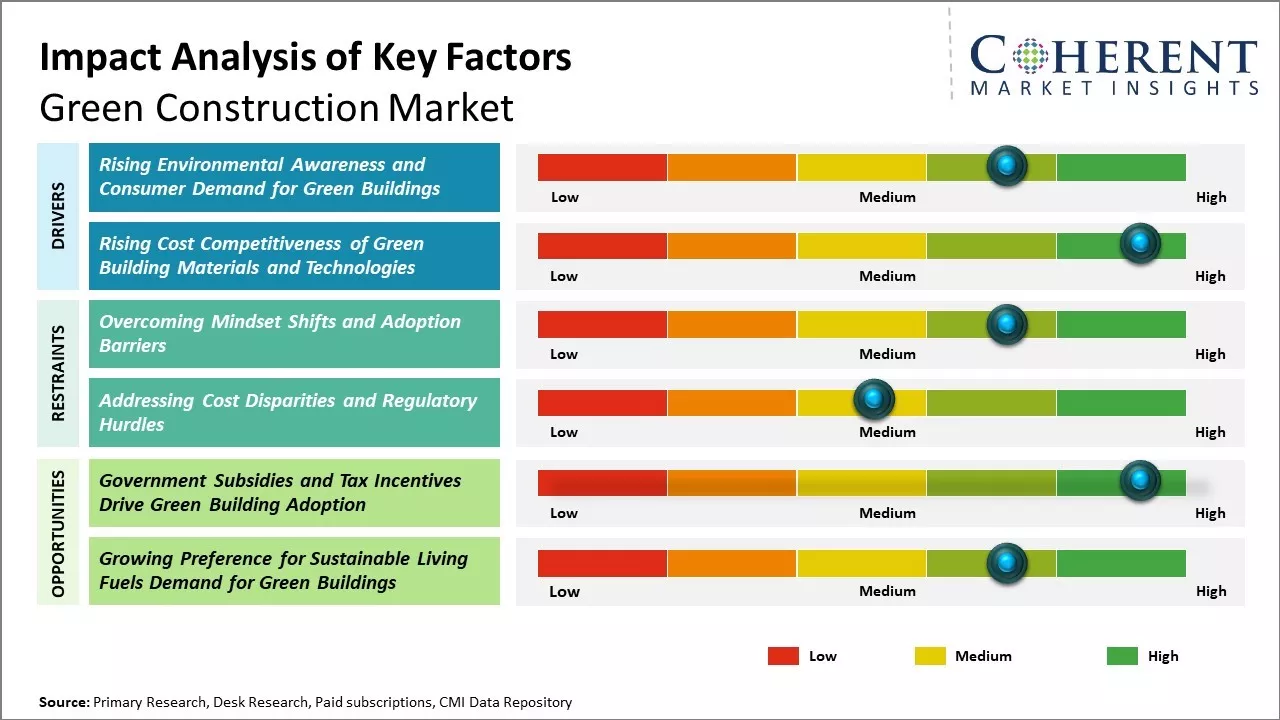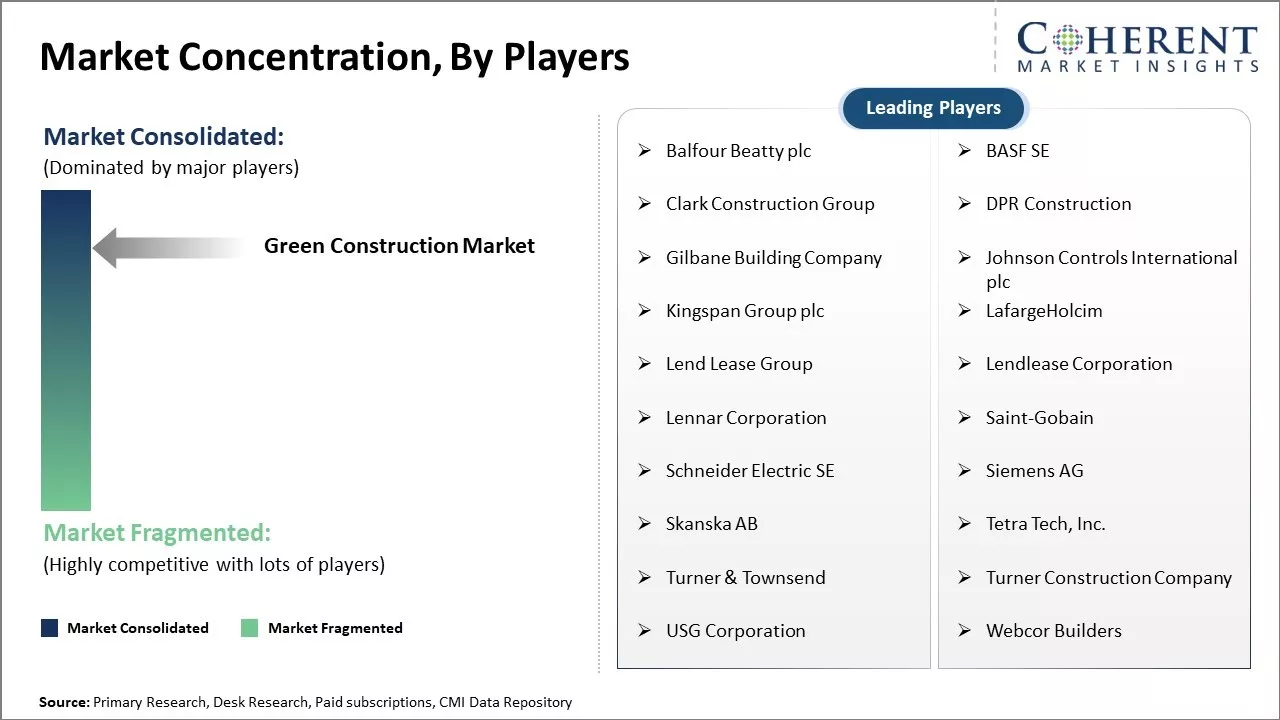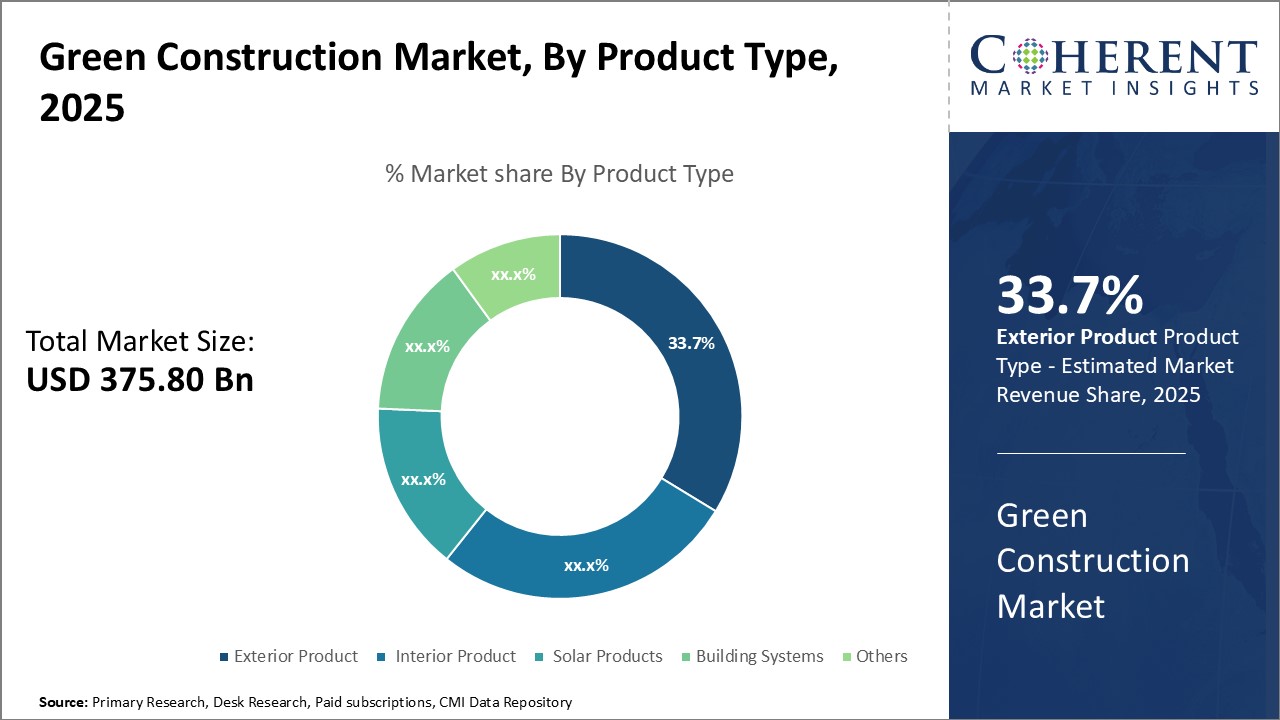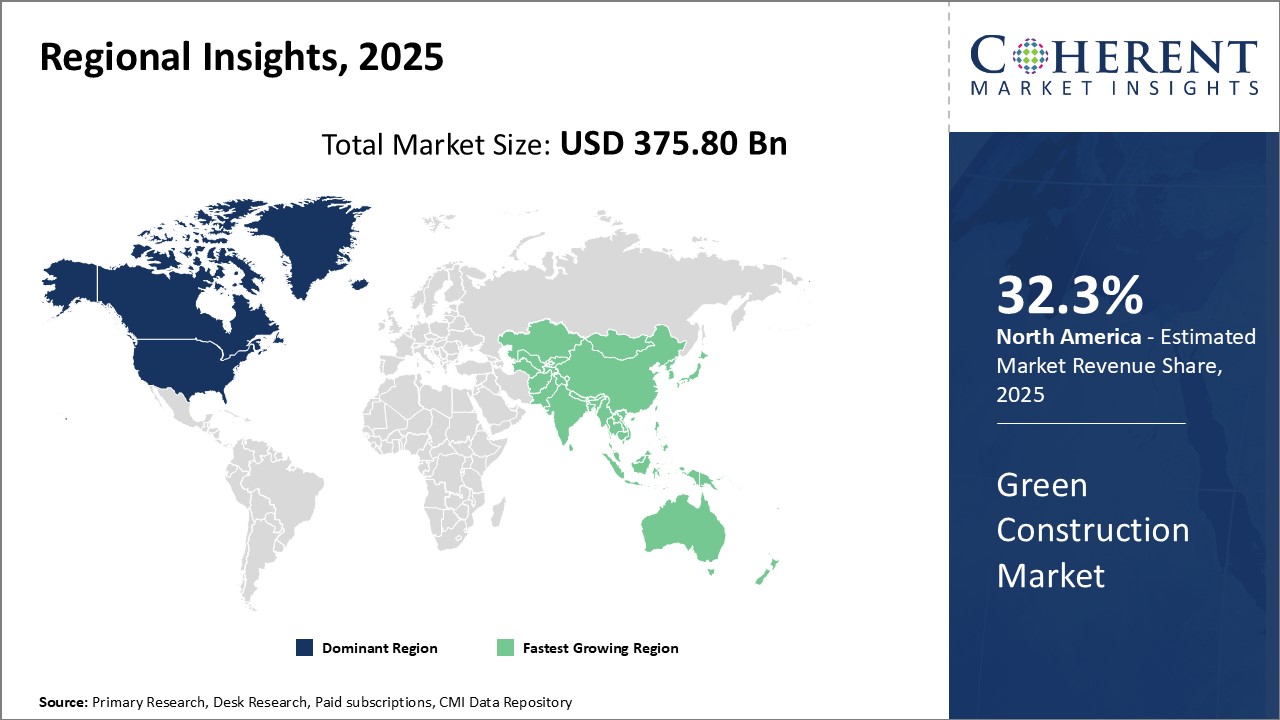Global green construction market is estimated to be valued at US$ 375.80 Billion in 2025 and is expected to reach US$ 780.72 Billion by 2032, exhibiting a compound annual growth rate (CAGR) of 11.0% from 2025 to 2032.

Discover market dynamics shaping the industry: Request sample copy
The market growth is driven by need for sustainable construction practices and focus on reducing carbon emissions from the construction sector. Governments across regions have implemented various regulations to promote the use of energy-efficient green buildings and materials. Evolving consumer preferences for environmentally friendly construction methods boosts the adoption of green construction practices. With continued policy push and rising consumer awareness, the green construction market can witness growth in the near future.
Rising Environmental Awareness and Consumer Demand for Green Buildings
Growing concerns over climate change and environmental degradation have increasingly put the spotlight on sustainability in the construction industry. More people are recognizing the significant impact that buildings have on the environment throughout their lifespan, from the resource consumption and emissions involved in material extraction and manufacturing, to the ongoing energy and water use of completed structures. As environmental issues receive broader public attention, consumers are witnessing stronger demand for green building designs and technologies that minimize environmental footprint. Developers have taken note, with many touting the environmental and wellness benefits of their projects as a key marketing strategy. The preference for sustainable properties is particularly prominent among younger generations and families with children, indicating this consumer priority can intensify in the near future. The movement towards more resource-efficient, emissions-reducing building practices is driven by shifting social values and purchaser preferences.
For instance, in March 2022, Malawi, experiencing rapid urbanization, witness high demand for housing, requiring around 21,000 new units annually for the next decade. However, locally produced building materials, especially in the informal sector, often fail to meet quality standards, leading to increased costs and structural risks. The cement and building material sector contribute significantly to emissions in the absence of large industries in other sectors. Despite government efforts to promote sustainable building materials, enforcement remains challenging due to various factors.
To address these challenges, the LC3 technology was introduced in Malawi. This innovative method aims to boost local and greener cement production, reducing the country's reliance on imports. Piloted countrywide in collaboration with cement producers under a public-private partnership can promote an environmentally friendly building material sector.

Get actionable strategies to beat competition: Request sample copy
Rising Cost Competitiveness of Green Building Materials and Technologies
While initial costs may have been higher in the past, green building materials and technologies are becoming increasingly cost competitive with traditional alternatives. Due to growing economies of scale in production, as well as continuous technological advancement, the pricing of many sustainable building components has decreased substantially in recent years and in numerous cases now matches or undercuts conventional options. Items like higher-efficacy lighting, water-saving fixtures, and low-e windows are priced competitively as compared to standard models. The utilization of renewable energy systems, superior insulation, and automated control systems can significantly reduce long-term energy bills for owners and tenants. When considering operating costs over the full life cycle of a structure, a greener design is often the most financially sensible choice . With blending of upfront cost parity and lower maintenance expenses, green construction is demonstrating itself as a sound economic decision rather than just an environmental priority. This convergence of competitive pricing and operational savings further boosts its mainstream adoption.
Key Takeaways from Analyst:
Global green construction market growth is driven by rising environmental awareness and focus on sustainability among builders, developers, and homeowners. Increased regulations regarding energy-efficiency in new developments also boosts green building practices.
Various financial incentives and tax rebates offered by governments worldwide to promote green construction can also drive the market growth. However, high initial costs can hamper widespread adoption of green building techniques.
Use of new energy-efficient and eco-friendly materials can hamper the market growth due to their higher prices as compared to conventional materials. North America currently dominates the green construction market owing to stringent LEED certification standards and growing demand for sustainable residential projects.
The market growth in Europe is driven by supportive policies like the Energy Performance of Buildings Directive. Asia Pacific is expected to witness the fastest growth due to rapid urbanization, rising income levels and government initiatives for green infrastructure development in China and India.
Green builders have an opportunity to significantly expand through offering cheaper and customized solutions designed for emerging markets. Long-term savings on utility bills could help overcome the higher upfront costs perception.
Adoption of prefabricated and modular construction techniques can offer opportunity to reduce expenses and construction time for green projects.
Market Challenges: Overcoming Mindset Shifts and Adoption Barriers
Global green construction market faces challenges due to deeply ingrained preferences for traditional cement and concrete-based materials. Convincing builders and investors to embrace newer, sustainable alternatives requires substantial time and effort, thus, impeding widespread adoption of green materials and technologies.
Market Opportunities: Government Subsidies and Tax Incentives Drive Green Building Adoption
Increasing government subsidies and tax incentives can provide a significant opportunity for the green building market. These initiatives aim to bridge the price gap between traditional and green buildings, making sustainable construction more financially viable for developers. Such incentives encourage greater adoption of environmentally friendly practices in construction projects.

Discover high revenue pocket segments and roadmap to it: Request sample copy
Insights, By Product Type, Exterior products drive green construction growth
In terms of product type, exterior product segment is estimated to contribute the highest market share of 33.7% in 2025, owing to increasing focus on building envelope and sustainability. Exterior products such as green roof systems, insulation and building panels help reduce energy consumption and operational costs significantly.
Green roofs not only filter stormwater runoff and improve air quality but also act as natural insulators providing year-round insulation. These reduce building heat gain in summers and heat loss in winters thus lowering energy demand for heating and cooling. Most green roofs also extend the life of conventional roof membranes by protecting them from direct sunlight, wind and seasonal temperature fluctuations.
Advancements in insulation material science have led to the development of high-performance insulations that offer superior thermal and physical properties as compared to conventional materials. Mineral wool and spray foam insulations provide high resistance to heat transfer, moisture and air leakage. These ensure interior spaces remain thermally stable throughout the year without fluctuating temperature swings. This results in HVAC energy savings of 15-30%.
Sustainable building envelope systems using engineered wood, recycled plastics and bio-based materials are gaining popularity. These systems offer durable, self-insulating panels that require little maintenance. Structural insulated panels (SIPs), cross-laminated timber (CLT) and bio-composite exterior cladding reduce onsite construction waste and speed up assembly timelines. Their monolithic construction seals the building air-tight preventing thermal bridging and air leakage.
The focus on the building envelope underscores the importance given to optimize thermal performance and manage operational costs in green construction. Exterior products play a pivotal role in achieving energy efficiency goals through their innovative designs and building science approaches.
Insights, By Application- Non-Residential Projects Fuel Segment Growth
In terms of application, non-residential segment is estimated to contribute the highest market share of 55.7% in 2025. Sustainable commercial, institutional and industrial developments are gaining prominence due to their triple bottom line-oriented designs.
Green certification mandates by governments and clients have helped propel resource-efficient standards in non-residential verticals. Buildings seeking LEED, BREEAM and ESTIDAMA certifications emphasize optimizing energy consumption, water recycling, IEQ enhancement and reducing carbon footprint. Advanced HVAC, lighting and renewable energy systems installed during design and construction helps lower operating costs by 25-30% over the lifecycle.
Institutional campuses integrate rooftop solar panels, sustainable landscaping and smart building technologies to minimize environmental impact. Green schools and hospitals have set benchmark sustainability agendas focused on occupant wellness, indoor air quality and maintenance of healthy micro-climates. Their greenhouse gas emissions reduction targets set new precedents for larger commercial developments to follow.
With green leases and corporate sustainability commitments, businesses are retrofitting existing infrastructure and designing new facilities with recycled content materials, natural ventilation and daylighting. Green office spaces offer higher occupant productivity along with recruitment and retention benefits from their wellness-centric work environments. Warehouse and logistics facilities similarly deploy renewable energy integration, electric vehicle charging and water efficiency solutions to lower energy consumption footprints.
The widespread move towards sustainable structures across non-residential end-uses like education, healthcare, retail and manufacturing is a major factor boosting demand for green building materials, technologies and services.

Need a Different Region or Segment? Customize now
North America has established itself as the dominant leader in the global green construction market with the estimated market share of 32.3% in 2025. The region has a large number of eco-friendly building projects due to stringent regulatory norms and growing consumer demand for sustainable buildings. Majority of the green buildings in the U.S. are certified under the LEED certification program developed by the U.S. Green Building Council (USGBC). With growing awareness about carbon footprint reduction, preservation of natural resources and health benefits of green buildings, contractors are widely adopting green building practices and materials in the residential and commercial construction sectors. States like California and Washington have set aggressive goals to reduce greenhouse gas emissions from buildings which is further boosting project initiation in the region.
Asia Pacific region is experiencing fastest growth in the green construction market with the CAGR of 13.1% for the forecast period of 2025-2031. China is leading the green building movement with largest green building floor area globally. The Chinese government is offering various incentives like tax benefits for green construction projects to achieve its national energy efficiency goals. This is encouraging wider adoption of energy-efficient and eco-friendly technologies by local contractors and builders. Countries like India, Japan, Malaysia and Vietnam are also witnessing surge in green building projects due to increased focus on sustainable infrastructure and strict enforcement of green building codes in various cities and states. Rapid urbanization and growing environmental regulations can boost demand for green materials in residential and commercial projects. Experts believe that APAC will surpass other regions in terms of annual green building investments in the coming years.
Green Construction Market Report Coverage
| Report Coverage | Details | ||
|---|---|---|---|
| Base Year: | 2024 | Market Size in 2025: | USD 375.80 Bn |
| Historical Data for: | 2020 To 2024 | Forecast Period: | 2025 To 2032 |
| Forecast Period 2025 to 2032 CAGR: | 11.0% | 2032 Value Projection: | USD 780.72 Bn |
| Geographies covered: |
|
||
| Segments covered: |
|
||
| Companies covered: |
Balfour Beatty plc, BASF SE, Clark Construction Group, DPR Construction, Gilbane Building Company, Johnson Controls International plc, Kingspan Group plc, LafargeHolcim, Lend Lease Group, Lendlease Corporation, Lennar Corporation, Saint-Gobain , Schneider Electric SE, Siemens AG, Skanska AB, Tetra Tech, Inc., Turner & Townsend, Turner Construction Company, USG Corporation, Webcor Builders |
||
| Growth Drivers: |
|
||
| Restraints & Challenges: |
|
||
Uncover macros and micros vetted on 75+ parameters: Get instant access to report
Share
Share
About Author
Ramprasad Bhute is a Senior Research Consultant with over 6 years of experience in market research and business consulting. He manages consulting and market research projects centered on go-to-market strategy, opportunity analysis, competitive landscape, and market size estimation and forecasting. He also advises clients on identifying and targeting absolute opportunities to penetrate untapped markets.
Missing comfort of reading report in your local language? Find your preferred language :
Transform your Strategy with Exclusive Trending Reports :
Frequently Asked Questions
Joining thousands of companies around the world committed to making the Excellent Business Solutions.
View All Our Clients
US Reciprocal Tax Impact Analysis On Green Construction Market
Stay updated on tariff changes with expert insights and timely information